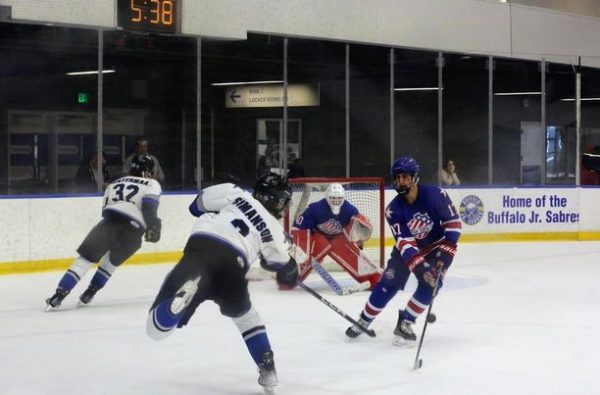It’s not just passing. It’s not just shooting. It’s not just scoring. It’s doing it all while on blades roughly three millimeters wide.
Senior Aiden Cheong details the unique skill set that comes with playing ice hockey.
“You need to be good at a lot of things. Skating, you have to have good stick skills, you need to have good awareness,” Cheong said. “The biggest thing is, once you’re 14 and above, that’s when they start hitting, so you have to be extra careful.”
The heightened physicality of ice hockey not only sets it apart from other contact sports, but also lends itself to its stereotypical melees.
“My team and I’ve been in a couple fights. For youth hockey, it’s either super serious or nothing. It’s not like the NHL where it’s just like a boxing match,” junior Gus Simonson said. “I wasn’t at this game because I was injured, but my team last season got into a 16-person fight on the ice with like eight suspensions, multiple concussions and broken [bones].”
Although Cheong has managed to avoid brawls such as these during his time with the sport, that has not managed to stunt his appreciation for the grit associated with being on the ice.
“There’s a lot of hitting, so you need to be balanced and keep your head up,” Cheong said. “I like how it’s fast-paced and the positions are pretty fluid. You can kind of play it however you like.”
Breaking the ice
In addition to the mechanics of the game, the connections formed on the team are another draw for Cheong.
“The main thing with sports in general, not just hockey, is that it gives you a source of social life and friends outside of school,” Cheong said. “I have my friends at base schools, friends at TJ and then friends I know from hockey.”
These bonds only strengthen as time spent with the team stacks as the season progresses. For Simonson, this sometimes gets in the way of the rigor of Jefferson.
“I have practices and conditioning every Tuesday and Thursday night, with two games a weekend, and then tournaments once or twice a month. I also have my own skills and conditioning some mornings throughout the week,” Simonson said. “It’s a lot to work with, but I feel like everyone at TJ has something else going on.”
In order to manage such an active schedule, Simonson adjusts his outlook on time spent at practice to be more productive.
“I treat [hockey] as a break almost; I’m not doing schoolwork while I’m on the ice or when I’m working out,” Simonson said. “I could just be at home watching something as my break but instead I’m at practice.”

one of the leagues we’re in coming up. And then we have state championships [in April] and then nationals.”
Tip of the iceberg?
As Simonson thinks down the line to college, balancing the equation of school work and hockey practice is thrown for a loop.
“I’ll hopefully play club hockey in college. Maybe, depending on the school I go to, I could walk on to their varsity, but I see myself right now just focusing on academics,” Simonson said. “If I get some opportunities with hockey, I’d happily take them.”
In spite of the sport’s unclear role in Simonson’s future, its influence on his life thus far is apparent.
“I’ve played my whole life so it’s kind of part of my identity. I’ve had the same coach since I was like seven, and I’ve known some of these kids for my entire life,” Simonson said. “It’s fast paced. It’s high energy. It’s fun.”


